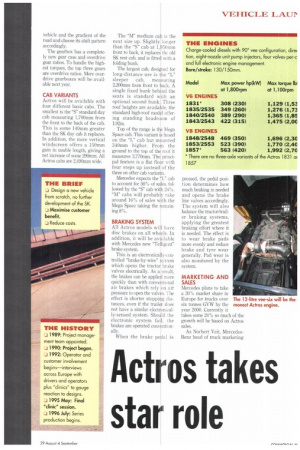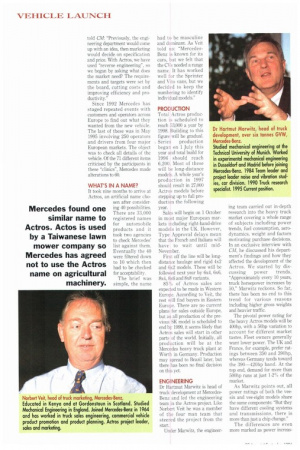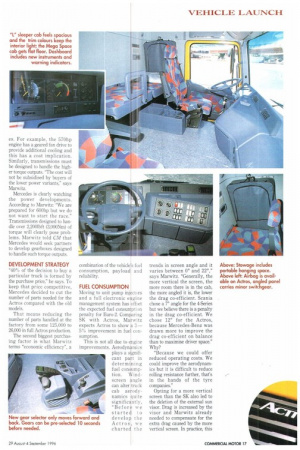M ercedes-Benz takes the wraps off its Actros heavy truck range
Page 16

Page 17

Page 18

Page 19

Page 20

If you've noticed an error in this article please click here to report it so we can fix it.
this week. Among the many innovations there are new engines, cabs and "Telligent" electronic control systems for the engines, advanced gearboxes and alldisc braking systems. With a planned production life of nine years, Actros will carry Mercedes into the 21st century.
ENGINES All Actros models will be powered by Mercedes' new 500 series vee-six 12-litre and vee-eight 16-litre engines (CM 11-17 July). Both share the same bore and stroke
dimensions. Power ratings span 308hp (230kW)-422hp (315kW) for the vee-six and 469hp (350kW)-563hp (420kW) for the vee-eight. Design features include fourvalves-per cylinder, unit pump injectors with eight-hole nozzles and full electronic engine management. The biggest advance as far as operators are concerned is the service intervals. These could be extended to somewhere between 100,000 and 120,000km, depending on vehicle usage. Fundamental to this is the "Telligent" diagnostic system, which will monitor and log faults and alert the driver if any system is faulty.
TRANSMISSIONS
Mercedes-Benz was the first manufacturer to fit semi-auto mated transmissions with the introduction of EPS in the mideighties. EPS will be replaced by its next development, the "Telligent" Shift System. Like EPS it is based on a 16-speed synchromesh gearbox but will offer the driver more functions than EPS. Gears can be preselected up to 10 seconds before they are needed and engaged by dipping the clutch. This speeds up gear selection, which will be more important for off-highway users.
The EPS gear selector is replaced by a redesigned gear shift which only moves fore and saft. Buttons on the side of the lever help select additional functions.
A fully automated version will also be available. It is able to calculate the weight of the vehicle and the gradient of the road and choose its shift pattern accordingly.
The gearbox has a completely new gear case and overdrive gear ratios. To handle the highest torques, the top three gears are overdrive ratios. More overdrive gearboxes will be available next year.
CAB VARIANTS Actros will be available with four different basic cabs. The smallest is the "S" standard day cab measuring 1,700mm from the front to the back of the cab. This is some 140mm greater than the SK day cab it replaces. In addition, the more vertical windscreen offers a 150mm gain in usable length, giving a net increase of some 290mm. All Actros cabs are 2,490mm wide.
The "M" medium cab is the next size up. Slightly longer than the "S" cab at 1,950mm front to back, it replaces the old SK rest cab, and is fitted with a folding bunk.
The largest cab, designed for long-distance use is the "L" sleeper cab, measuring 2,200mm from front to back. A single fixed bunk behind the seats is standard with an optional second bunk. Three roof heights are available, the standard high-roof model offering standing headroom of 1.92m.
Top of the range is the Mega Space cab. This variant is based on the "I," cab but mounted 340mm higher. From the ground to the top of the rot if it measures 3,770tnm. The principal feature is a flat floor with four steps up instead of the three on other cab variants.
Mercedes expects the "I," cab to account for 50% of sales, followed by the "S" cab with 26%. "M" cabs will probably take around 16% of sales with the Mega Space taking the remaining 8%.
BRAKING SYSTEM All Actros models will have disc brakes on all wheels. In addition, it will be available with Mercedes new "Telligent" brake system.
This is an electronically-controlled "brake-by-wire" system which opens the tractor brake valves electrically. As a result, the brakes can be applied more quickly than with conventional air brakes which rely on air pressure to open the valves. The effect is shorter stopping distances, even if the trailer does not have a similar electronically-sensed system. Should the electronic system fail, the brakes are operated conventionally.
When the brake pedal is pressed, the pedal position determines how much braking is needed and opens the brake line valves accordingly. The system will also balance the tractor/trailer braking systems, applying the greatest braking effort where it is needed. The effect is to wear brake pads more evenly and reduce brake and tyre wear generally. Pad wear is also monitored by the system.
MARKETING AND SALES Mercedes plans to take a 30% market share in Europe for trucks over six tonnes GYM,' by the year 2000. Currently it takes some 24°.0 so much of the growth will be based on Actros sales.
As Norbert Veit, MercedesBenz head of truck marketing
told CM: "Previously, the engineering department would come up with an idea, then marketing would decide on specification and price. With Actros, we have used "reverse engineering", so we began by asking what does the market need? The requirements and targets were set by the board, cutting costs and improving efficiency and productivity."
Since 1992 Mercedes has staged repeated events with customers and operators across Europe to find out what they wanted from the new vehicle. The last of these was in May 1995 involving 250 operators and drivers from four major European markets. The object was to check all details of the vehicle. Of the 71 different items criticised by the participants in these "clinics", Mercedes made alterations to 60.
WHAT'S IN A NAME?
It took nine months to arrive at Actros, an artificial name chosen after considering 40 possibilities. There are 33,000 registered names for automobile products and it took two agencies to check Mercedes' list against them. Eventually the 40 were filtered down to 10 which then had to be checked for acceptability.
The brief was simple, the name had to be masculine and dominant. As Veit told us: "MercedesBenz is known for its cars, but we felt that the CVs needed a range name. It has worked well for the Sprinter and Vito vans, but we decided to keep the numbering to identify individual models."
PRODUCTION
Total Actros production is scheduled to reach 53,000 a year by 1998. Building to this figure will be gradual.
Series production began on 1 July this year and total build for 1996 should reach 6,200. Most of these will be long-distance models. A whole year's production in 1997 should result in 27,000 Actros models before stepping up to full production the following year.
Sales will begin on 1 October in most major European markets including right-hand-drive models in the UK. However, Type Approval delays mean that the French and Italians will have to wait until midNovember.
First off the line will be longdistance haulage and rigid 4x2 and 6x2 models. These will be followed next year by 6x4, 6x6, 8x4, 8x6 and 8x8 variants.
85% of Actros sales are expected to be made in Western Europe. According to Veit, the rest will find buyers in Eastern Europe. There are no current plans for sales outside Europe, but as all production of the previous SK model is scheduled to end by 1999, it seems likely that Actros sales will start in other parts of the world. Initially, all production will be at the Mercedes heavy truck plant at Mirth in Germany. Production may spread to Brazil later, but there has been no final decision on this yet.
ENGINEERING
Dr Hartmut Marwitz is head of truck development at MercedesBenz and led the engineering team in the Actros project. Like Norbert Veit he was a member of the four man team that steered the project from the start.
Under Marwitz, the engineer ing team carried out in-depth research into the heavy truck market covering a whole range of subjects including power trends, fuel consumption, aerodynamics, weight and factors motivating purchase decisions. In an exclusive interview with CM, he discussed his department's findings and how they affected the development of the Actros. We started by dis
cussing power trends. "Approximately every 10 years, truck horsepower increases by 50," Marwitz reckons. Sc) far, there has been no end to this trend for various reasons including higher gross weights and heavier traffic.
The pivotal power rating for the heavy Actros models will be 400hp, with a 50hp variation to account for different market tastes. Fleet owners generally want lower power. The UK and France, for example, prefer ratings between 350 and 390hp, whereas Germany tends toward the 390-420hp band. At the top end, demand for more than 500hp runs at just 1-2% of the market.
As Marwitz points out, all power ratings of both the veesix and vee-eight models share the same components: "But they have different cooling systems and transmissions, there is more than just a chip change."
The differences are even more marked as power increas es. For example, the 570hp engine has a geared fan drive to provide additional cooling and this has a cost implication. Similarly, transmissions must be designed to handle the higher torque outputs. "The cost will not be subsidised by buyers of the lower power variants," says Marwitz.
Mercedes is clearly watching the power developments. According to Marwitz: "We are prepared for 600hp but we do not want to start the race." Transmissions designed to handle over 2,200Ibft (3,000Nm) of torque will clearly pose problems. Marwitz told CM that Mercedes would seek partners to develop gearboxes designed to handle such torque outputs.
DEVELOPMENT STRATEGY "40% of the decision to buy a particular truck is formed by the purchase price," he says. To keep that price competitive, Mercedes decided to cut the number of parts needed for the Actros compared with the old models.
That means reducing the number of parts handled at the factory from some 125,000 to 26,000 in full Actros production.
The second biggest purchasing factor is what Marwitz terms "economic efficiency". 71
combination of the vehicle's fuel consumption, payload and reliability.
FUEL CONSUMPTION Moving to unit pump inject,,rs and a full electronic engine management system has offset the expected fuel consumpti(in penalty for Euro-2. Comparing SK with Actros, Marwitz expects Actros to show a 3 — 5% improvement in fuel consumption.
This is not all due to eigine improvements. Aerodynamics plays a significant part in determining fuel consumption. Windscreen angle can alter truck cab aerodynamics quite significantly, "Before we started to develop the Actros, we charted the
trends in screen angle and it varies between 00 and 22°," says Marwitz. "Generally, the more vertical the screen, the more room there is in the cab, the more angled it is, the lower the drag co-efficient. Scania chose a 70 angle for the 4-Series but we believe there is a penalty in the drag co-efficient. We chose 12° for the Actros, because Mercedes-Benz was drawn more to improve the drag co-efficient on balance than to maximise driver space." Why?
"Because we could offer reduced operating costs. We could improve the aerodynamics but it is difficult to reduce rolling resistance further, that's in the hands of the tyre companies."
Opting for a more vertical screen than the SK also led to the deletion of the external sun visor. Drag is increased by the visor and Marwitz already needed to compensate for the extra drag caused by the more vertical screen. In practice, this screen means the Actros has less direct sunlight in the cab and the need for the visor was reduced.
PAYLOAD Unlike the SK, there are no cab width options for the Actros. Because the standard cab width has increased from 2.3m to 2.49m. the Actros incurred a 100kg weight penalty from the start. The original target was to lighten the chassis by 400kg compared with the SK. The heavier cab meant that 300kg had to be shed and the chassis was the first target. The chassis sidemember height has been reduced—comparing the Actros 1840LS with the previous 1838LS it measures 283.4mm compared with 314mm. Thinner section steel is also used-6.7mm compared with 7mtn. To compensate, the whole chassis is fabricated from higher strength steel.
Standard drive axle air suspension yielded a further 50kg weight saving (steel is a no-cost option) and all-round disc brakes also saved 50kg. A further 100kg was shed in the driveline. Comparing the vee-six Actros 1840LS and the vee-eight 1838 LS again, the Actros shows an approximate saving of 290kg, weighing in at 7,035kg.
RELIABILITY Target reliability of the Actros was double that of its predecessor. For this reason, Mercedes decided on single sourcing of its volume components to give greater consistency of quality.
"Five breakdowns a year will wipe out a fleet owner's profit from that truck," says Marwitz. Some 30°. of reliability prob lems are related to electronics and two thirds of the problems are caused by poor connections. Mercedes focused on these for the Actros, switching from tin to silver for most connections. For safety systems such as ABS, gold is used. New connectors were also designed. Push and twist bayonet-type connectors offered the best solution and in addition these are filled with plastic material to secure against corrosion and water penetration.
Electronic systems are used more widely on the Actros than on the SK, so the potential for electrical problems is greater. According to Marwitz: "The SK had 143 wires with two connectors each for the vehicle electronic systems. The Actros has only eight wires because of its CANBUS system." This uses a single wire to carry data for the "Telligent" control and monitoring systems such as engine management. ABS or fault diagnosis. A stream of data is sent every 50 milliseconds. The system was developed from the 5class passenger car but is the first such system used on a• truck.
Doubling the reliability of the vehicle had another aim—doubling the service intervals. The target was 100,000km or more. This interval depends on usage but the standard Telligent maintenance system can extend it to 120,000km.
Automatic chassis lubrication has been eliminated, saving 20-25kg, by adopting maintenance-free rubber molecular bearings. The joint eliminates friction surfaces, movement is in the elasticity of the rubber compound so it does not require lubrication.
L See flex! week's CM for full driving impressions of the Actros.








































































































